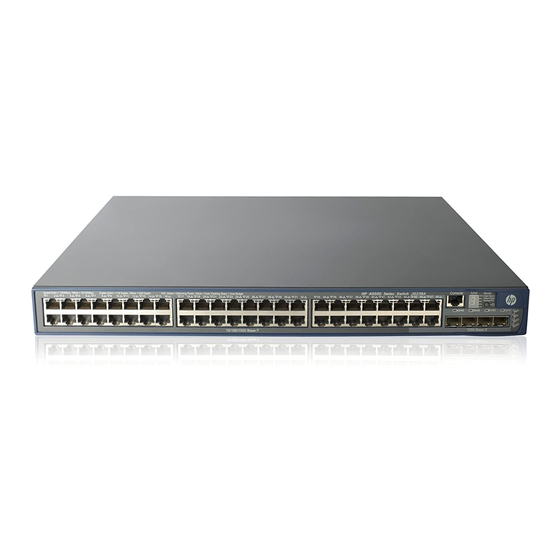HP 5500-24G-SFP EI TAA Specifications - Page 3
Browse online or download pdf Specifications for Switch HP 5500-24G-SFP EI TAA. HP 5500-24G-SFP EI TAA 47 pages. Hp 5500 hi switch series
Also for HP 5500-24G-SFP EI TAA: Quickspecs (35 pages), Product End-Of-Life Disassembly Instructions (4 pages)

QuickSpecs
Overview
Nonblocking architecture
up to 192 Gb/s nonblocking switching fabric provides wire-speed switching with up to 143 million pps throughput
Hardware-based wirespeed access control lists (ACLs)
help provide high levels of security and ease of administration without impacting network performance with a feature-rich
TCAM-based ACL implementation
Resiliency and high availability
Separate data and control paths: keeps control separated from services and keeps service processing isolated; increases
security and performance
External redundant power supply: provides high reliability
Smart link: allows 50 ms failover between links
Spanning Tree/MSTP, RSTP: provides redundant links while preventing network loops
Rapid Ring Protection Protocol (RRPP): connects multiple switches in a high-performance ring using standard Ethernet
technology; traffic can be rerouted around the ring in less than 50 ms, reducing the impact on traffic and applications
Virtual Router Redundancy Protocol (VRRP): allows a group of routers to dynamically back each other up to create highly
available routed environments
Intelligent Resilient Framework (IRF): creates virtual resilient switching fabrics, where two or more switches perform as a
single L2 switch and L3 router; switches do not have to be co-located and can be part of a disaster recovery system; servers or
switches can be attached using standard LACP for automatic load balancing and high availability; can eliminate the need for
complex protocols like Spanning Tree Protocol, Equal-Cost Multipath (ECMP), or VRRP, thereby simplifying network operation
IP Fast Reroute (FRR): forms backup paths and allows 50 ms switchover in case of a main path fault
Layer 2 switching
32K MAC addresses: provide access to many Layer 2 devices
IEEE 802.1ad QinQ and Selective QinQ: increase the scalability of an Ethernet network by providing a hierarchical structure;
connect multiple LANs on a high-speed campus or metro network
GARP VLAN Registration Protocol: allows automatic learning and dynamic assignment of VLANs
IEEE 802.1ad QinQ: increases the scalability of an Ethernet network by providing a hierarchical structure; connects multiple LANs
on a high-speed campus or metro network
10 GbE port aggregation: allows grouping of ports to increase overall data throughput to a remote device
Internet Group Management Protocol (IGMP) and Multicast Listener Discovery (MLD) protocol snooping: effectively control
and manage the flooding of multicast packets in a Layer 2 network
Layer 3 services
Address Resolution Protocol (ARP): determines the MAC address of another IP host in the same subnet
Dynamic Host Configuration Protocol (DHCP): simplifies the management of large IP networks and supports client and server;
DHCP Relay enables DHCP operation across subnets
Loopback interface address: defines an address in Routing Information Protocol (RIP) and Open Standard Path First (OSPF),
improving diagnostic capability
User Datagram Protocol (UDP) helper function: allows UDP broadcasts to be directed across router interfaces to specific IP
unicast or subnet broadcast addresses and prevents server spoofing for UDP services such as DHCP
Route maps: provide more control during route redistribution; allow filtering and altering of route metrics
Layer 3 routing
IPv4 routing protocols: support static routes, RIP, OSPF, ISIS, and BGP
IPv6 routing protocols: provide routing of IPv6 at wire speed; support static routes, RIPng, OSPFv3, IS-ISv6, and BGP4+ for IPv6
DA - 13808 North America — Version 27 — January 16, 2014
HP 5500 EI Switch Series
Page 3
